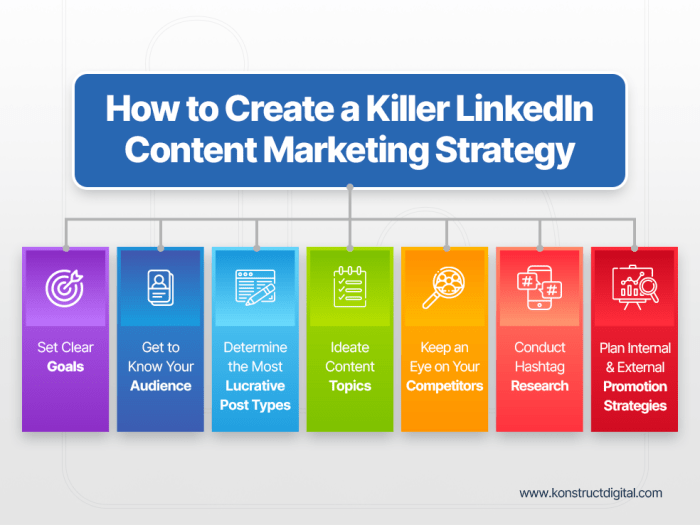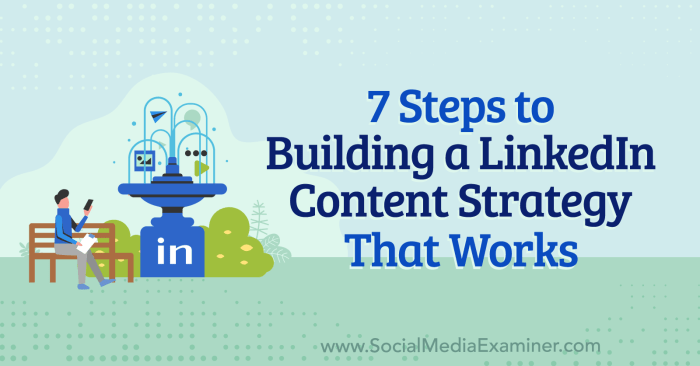Creating a LinkedIn Content Strategy sets the stage for a dynamic journey into the world of strategic content creation, where every post is a piece of the puzzle in building your online presence.
Uncover the secrets to maximizing engagement, boosting visibility, and connecting with your audience on LinkedIn like a pro.
Importance of LinkedIn Content Strategy
Having a well-defined content strategy on LinkedIn is crucial for both individuals and businesses looking to establish a strong online presence. It allows you to showcase your expertise, build credibility, and engage with your target audience effectively. A strategic approach to content creation can help you stand out in a crowded digital space and achieve specific goals on the platform.
Examples of Successful LinkedIn Content Strategies
- Sharing valuable industry insights and thought leadership content to position yourself as an authority in your field.
- Creating engaging visual content such as infographics or videos to capture the attention of your audience and drive higher engagement.
- Consistently posting relevant and timely updates to keep your followers informed and connected.
Impact of Strategic Content Creation
By implementing a well-thought-out content strategy on LinkedIn, individuals and businesses can increase their visibility, attract more followers, and ultimately drive conversions. It helps in building a strong network, fostering relationships, and generating leads.
Identifying Target Audience
Identifying the target audience is crucial before creating a LinkedIn content strategy. Understanding who your audience is helps tailor your content to their needs and preferences, leading to better engagement and conversion rates.
Researching and Analyzing Demographics
To research and analyze the demographics of your target audience, you can use tools like LinkedIn Analytics to gather data on their age, location, job titles, and industries. Conduct surveys, interviews, and analyze social media insights to get a deeper understanding of their preferences and behaviors.
- Utilize LinkedIn Analytics to gather demographic data
- Conduct surveys and interviews to understand preferences
- Analyze social media insights for behavioral patterns
Aligning Content with Interests
Aligning your content with the interests of your target audience is key to driving engagement and conversions. Create content that resonates with their needs, challenges, and interests to establish a connection and build trust with your audience.
- Create content that addresses the needs and challenges of your audience
- Personalize content based on their interests and preferences
- Use relevant s and hashtags to attract the target audience
Types of Content for LinkedIn
When it comes to creating content for LinkedIn, it’s important to diversify the types of posts you share to keep your audience engaged. Here are some of the most effective content formats suitable for LinkedIn:
Articles
Articles are a great way to showcase your expertise and provide valuable insights to your connections. They allow for more in-depth content and can help position you as a thought leader in your industry. For example, a marketing professional could write an article about the latest trends in digital marketing and share it with their network.
Posts
Regular posts are short updates that appear in the feed of your connections. These can include industry news, updates on your projects or achievements, or even just sharing interesting articles or resources. For instance, a tech company could post about a new product launch or share a relevant industry report.
Videos
Videos are becoming increasingly popular on LinkedIn as they are engaging and can help you stand out in a crowded feed. You can create videos that showcase your work, provide tutorials or tips, or even share behind-the-scenes glimpses of your company culture. A recruitment agency could post a video featuring interviews with employees to give potential candidates a sense of the company culture.
Infographics
Infographics are visually appealing and can help simplify complex information. They are great for sharing statistics, data, or processes in a more digestible format. For example, a finance professional could create an infographic breaking down the steps of a complex investment strategy.
Diversifying your content types on LinkedIn can help you reach a wider audience as different people prefer consuming different types of content. It also keeps your feed interesting and engaging, leading to increased visibility and interaction with your posts.
Content Creation and Scheduling

Creating captivating content on LinkedIn is crucial for engaging your audience and building your brand. Here are some best practices to help you create compelling and valuable content that resonates with LinkedIn users.
Crafting Engaging Content
- Understand your audience: Tailor your content to meet the needs and interests of your target audience to ensure it resonates with them.
- Utilize storytelling: Share personal anecdotes, case studies, or success stories to make your content more relatable and engaging.
- Incorporate visuals: Use high-quality images, infographics, or videos to capture the attention of your audience and increase engagement.
- Add value: Provide valuable insights, tips, or industry news that your audience can benefit from to establish yourself as a thought leader.
Tools for Content Creation and Scheduling
- Content creation: Platforms like Canva, Adobe Spark, or Piktochart can help you design visually appealing graphics and images for your posts.
- Editing tools: Tools like Grammarly or Hemingway can assist in proofreading and editing your content to ensure it is error-free.
- Social media management tools: Platforms such as Hootsuite or Buffer can help you schedule and automate your LinkedIn posts for optimal timing and visibility.
Content Calendar and Scheduling Tips, Creating a LinkedIn Content Strategy
- Create a content calendar: Plan your content in advance to ensure consistency and alignment with your marketing goals.
- Identify optimal posting times: Use LinkedIn analytics to determine when your audience is most active and schedule your posts during those peak times for maximum visibility.
- Experiment with different formats: Test out various types of content such as articles, videos, or polls to see what resonates best with your audience and adjust your content strategy accordingly.
Engaging with the LinkedIn Community: Creating A LinkedIn Content Strategy

Engaging with the LinkedIn community is crucial for building relationships, establishing authority, and increasing visibility on the platform. By actively participating through comments, shares, and messages, you can create a more meaningful presence and expand your network.
Strategies for Meaningful Interactions
To foster meaningful interactions on LinkedIn, consider the following strategies:
- Respond to comments on your posts to show appreciation and encourage further engagement.
- Share valuable content from others in your network to support their efforts and build reciprocity.
- Personalize messages when connecting with new contacts to start the relationship on a positive note.
- Participate in relevant groups and discussions to showcase your expertise and connect with like-minded professionals.
Role of Engagement in Growth
Engagement plays a vital role in growing your network, establishing authority, and increasing visibility on LinkedIn. By actively engaging with others, you can showcase your knowledge, build trust, and attract new opportunities. Remember, it’s not just about posting content but also about interacting with others to build a strong presence on the platform.